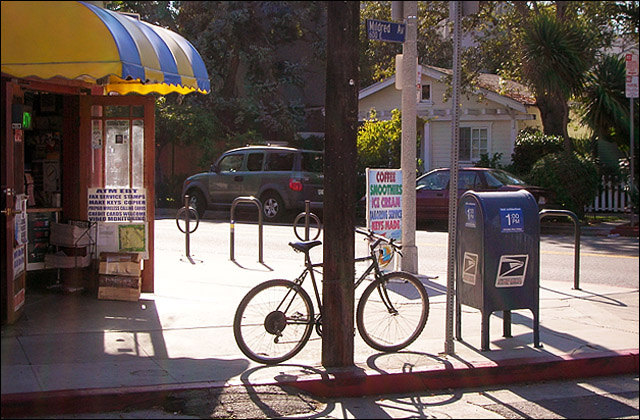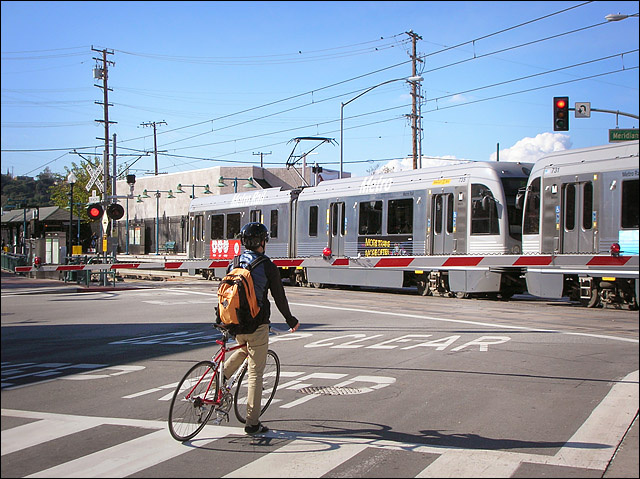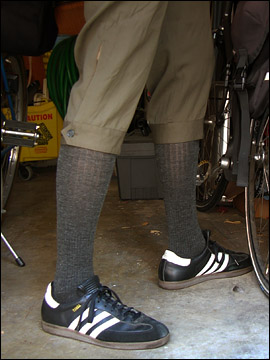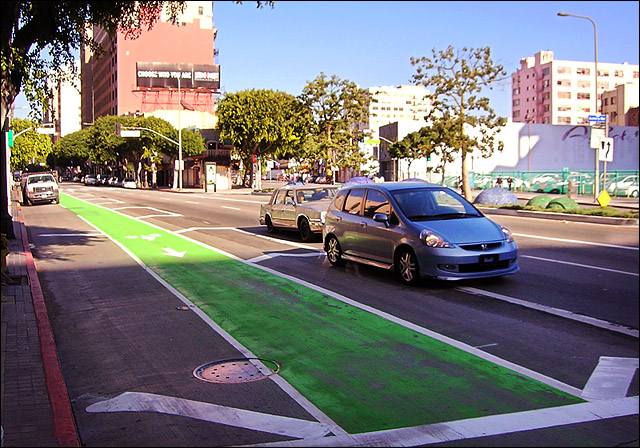Less certain is the advent of our mandarin-collar merino jersey, which we were preparing to make just as the Great Recession fell upon us. I've been wearing the poor sample for three years. almost every day for half the year, and everyone loves it--though not as much as I do, for I get to wear it, and it is sweet!
So keep your eye on this blog for the announcements--or click on the link to the "Comments" page on the left and send me a note asking me to let you know by email when they're ready.
Look good, feel good, ride happy!
Richard Risemberg on Sat, 31 Dec 2011 14:01:35 -0800 [link]
And at Flying Pigeon, I think about traffic, cycling, and business on the back side of LA's Silerlake neighborhood, in Road Diet à Deux.
Richard Risemberg on Thu, 29 Dec 2011 10:03:58 -0800 [link]

That's right--there are four fine, functional, and wide-open bike parking racks on this Venice corner in front of a popular neighborhood store.
And there is one bike there--chained to a telephone pole!
Those four racks can hold a total of eight bicycles quite easily. The store they serve is very small. The chances that eight bikes were locked up here when the one in the photo arrived, and that all but this one left subsequently, is rather low.
I've seen roadies ignore racks and maneuver their bikes behind sidewalk tables now and then, but that's because the roadie religion doesn't allow them to carry locks. But this bike is locked! (The chain is easy to see in the original image.)
I see the same phenomenon on Wilshire Boulevard near my apartment as well, fairly often: a perfectly good, quite empty rack, or two--and a bike locked to a meter, or a signpost, or a tree, not ten feet away.
Not just shabby old mountain bikes, either, but shiny new hybrids, or fixies, or fake Dutch bikes.
I take it personally, as I've gotten dozens and dozens of bike racks installed in LA by using the city's bike rack request form. Though I am happy to admit that most of them end up with bicycles actually locked to them.
But this widespread spurning of convenient bike racks just puzzles me to no end.
Well...I suppose it's of a piece with those moronic drivers who zoom past you repeatedly on residential roads, only to be caught at lights long enough for you to catch up to them on your bike, over and over again. But at least all that sound and fury gives the driver the illusion of gain. I really can't imagine what sort of misguided thrill rack-spurning engenders in its practitioners.
It's a conundrum....
Richard Risemberg on Fri, 23 Dec 2011 21:29:02 -0800 [link]
Then wash it down with a bit of good news (flavored with only a dash of worry) about the Silverlake-Atwater Express at Flying Pigeon LA.
Richard Risemberg on Wed, 21 Dec 2011 20:16:16 -0800 [link]
It comes in half-width rolls, which left me wondering what to do with it--all our patterns are for 44 or 58 inch rolls--when I realized I have two projects for which this would be perfect:
- A daybag--something akin to a small messenger bag but dressier--more like a dispatch bag. My preliminary drawing is sitting by my elbow as I type.
- A shop apron. This really pleases me, as I have already designed a shop apron and made a sample, as it were, at the request of one of the mechanics at Flying Pigeon LA, who is using it now and very pleased with it. (In fact, several of the mechanics take turns wearing it.)
Richard Risemberg on Tue, 20 Dec 2011 16:17:00 -0800 [link]
And at Flying Pigeon LA I talk about coexisting with urban rail lines in Real Track Riding (reprising my comments in the previous entry on this blog with some new details).
The truth is, I love trains almost as much as I love bikes--and they're good for cities, and cycling!
Richard Risemberg on Wed, 14 Dec 2011 18:42:24 -0800 [link]

And every time I cross them, I think about all those complaints US cyclists have been posting to their various online venues about how awful and dangerous tram tracks are to cyclists.
Yet trams were already a feature of cities when bicycles became popular, and cyclists have been co-existing peacefully with them for well over a century (as in this film montage from Barcelona, photographed in 1908). And of course almost all European cities, as well as many Japanese ones, have trams, and also have much higher percentages of cyclists on the roads than even Portland.
I never have any trouble from tram tracks, and, as I sit at Buster's with Chuck, I see rider after rider go by and cross the tracks--roadies, fixie punks, shoppers on hybrids, old folks on cruisers, fat tires and skinny, lots...there are many, many cyclists in that area. I've never seen anyone so much as wobble. I even rode across once with a flat tire before I noticed and pulled over to patch the tube.
America nearly obliterated urban rail service in the car-mad '50s and '60s, so maybe we're just not used to it any more.
Maybe all we need is a little bit of practice and attentiveness.
Metro has come a long, long way in making their trains (and buses) more bike-friendly, finally lifting all restrictions on brining your bike aboard earlier this year. Urban rail is a superb way to move people around, with or without their bikes. Let's do our part and learn how to ride over tram tracks.
The rest of the world's been doing it for a hundred and twenty five years so far. I'll be we can get the hang of it ourselves in pretty short order.
Richard Risemberg on Tue, 13 Dec 2011 22:03:41 -0800 [link]
 The doorbell rang late at night, and there on the porch was a box of sox to fill our stock. A bit late, as usual, but they've arrived: we now have a full stock of Bicycle Fixation Knicker Socks!
The doorbell rang late at night, and there on the porch was a box of sox to fill our stock. A bit late, as usual, but they've arrived: we now have a full stock of Bicycle Fixation Knicker Socks!The perfect companion to any knickers (but especially our own, of course), they also work well with long pants or even winter bike tights.
Like all our products, our socks help you look good, feel good, and ride happy. And they're versatile: riders from the Arizona deserts to the Canadian tundra love 'em and use 'em, whether for weekend jaunts or to ride to work.
See them here.
Richard Risemberg on Wed, 07 Dec 2011 18:53:46 -0800 [link]
Orange 20 got a post on the aftermath of LA's recent crazy windstorm...and how easily our bikes were able to negotiate the Tour de Mess.
And Flying Pigeon LA hosts my screed on LA's inveterate habit of unnecessarily Reinventing the Wheel.
Richard Risemberg on Wed, 07 Dec 2011 13:12:44 -0800 [link]
The lane was first painted last week, possibly (as rumors have it) to be ready for a grand opening ceremony. Unfortunately, this was just before a massive rainstorm that had been looming for over a week. This, as you can imagine, played hell with the paint.
So, a few days later it was painted again--though according to my friends at the Los Angeles County Bicycle Coalition (responding to a whiny email of mine), only the segment from 4th to 9th was redone.
As it happened, I rode the entire length of the new lane today on my way to the garment factory, and I happened to get a photo of the 9th Street end of it, which I present as Exhibit A below:

Not looking too good, is it?
It's a pity, as the lane itself is pretty well-designed, seems to keep drivers in their place, and doesn't throw any funny jogs at you as so many half-baked lanes do. It's really quite nice, and takes you through a corridor of wonderful Art Deco skyscrapers housing restaurants, offices, stores, and other useful destinations, as well as most of the buildings in the Civic Center, including City Hall itself. But people are already making fun of it because the paint is flaking off after only a week.
Still, if you're in LA, give it a try. It's a comfortable ride to places you will want or need to go to, and will soon connect with the extended 7th Street lanes and possibly some others. (It runs westbound; there's an eastbound companion lane a block over on Main Street, but I don't believe that one's green.)
LA just needs a little help with paint technology.
Richard Risemberg on Tue, 06 Dec 2011 21:16:02 -0800 [link]
Occupy All Streets: The Role of Carfree Cities in a More Sustainable World from J.H. Crawford on Vimeo.
Crawford and I have worked together on urban and carfree issues for many years--my son and I contributed photos to his books, Carfree Cities and Carfree Design Manual, and I helped a bit with the Los Angeles map in the video.We can't really build a pleasurable, healthy, sustainable life in our cities if we continue to jam them full of cars to the exclusion of everything else--and their effect on the economy, thanks to the massive hidden subsidies driving requires, is even worse.
Crawford's work is some of the most highly developed in this line. You could do worse than to browse his website after seeing the video.
Richard Risemberg on Fri, 02 Dec 2011 08:44:31 -0800 [link]



